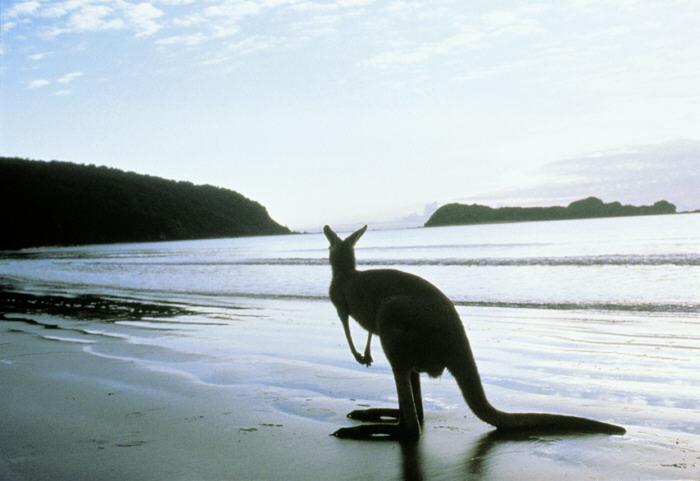
Kangaroo Island wallpaper
Kangaroo Island is Australia's third-largest island after Tasmania and Melville Island. It is 112 kilometres (70 mi) southwest of Adelaide at the entrance of Gulf St Vincent. At its closest point to the mainland, it is 13 kilometres (8 mi) offshore from Cape Jervis, on the tip of the Fleurieu Peninsula in the state of South Australia. The island is 150 km (93 mi) long and between 900 m (980 yd) and 57 km (35 mi) wide, its area covering 4,405 km2 (1,701 sq mi). Its coastline is 540 kilometres (340 mi) long and highest altitude is 307 m (1,010 ft). It is separated from Yorke Peninsula to the northwest by Investigator Strait and from Cape Jervis to the northeast by Backstairs Passage.
History
Kangaroo Island was separated from mainland Australia by a rise in sea level over 9,000 years ago. Stone tools found suggest that Aboriginal people occupied the land at least 11,000 years ago; it is supposed that they disappeared in 200 BC. Theories about the cause include disease and inbreeding, warfare, climatic change or exodus.
In 1802 British explorer Matthew Flinders, Commanding HMS Investigator, named the land "Kanguroo (sic) Island" after landing near Kangaroo Head on the north coast of Dudley Peninsula. He was closely followed by the French explorer Nicolas Baudin, who mapped much of the island (which is why so many areas have French names). Although the French and the British were at war at the time, the men met peacefully. They both used the fresh water seeping at what is now known as Hog Bay near Frenchman's Rock; the community is now called Penneshaw.
An unofficial community of sealers and others was set up on Kangaroo Island from 1802 to the time of South Australia's official settlement in 1836. The sealers were rough men and several kidnapped Aboriginal women from Tasmania and mainland South Australia. The women were forced to do the work of sealers, amongst other activities. Three Aboriginal women tried to escape and swim back to the mainland; one is on record as having survived the journey. The first ship to arrive was the Duke of York commanded by Captain Robert Clark Morgan (1798–1864).
Townships
The biggest town on Kangaroo Island is Kingscote. Originally established at Reeves Point on 27 July 1836, it is South Australia's first official European settlement. It was later suggested that Kingscote could serve as the capital of South Australia, but the island's resources were insufficient to support such a large community, so the settlement of Adelaide was chosen.
Penneshaw, the second largest town on Kangaroo Island, has a population of around 300, and is located on the north eastern tip of the Dudley Peninsula, on the eastern end of the island. It is home to the ferry terminal which brings most of the visitors to the island, along with all the necessary freight to sustain the local population. Parndana is the third largest town on Kangaroo Island, and is home to a population of around 150, however most of this population do not live in the town, they are sprawled within a few kilometres.
The historic area to the south-east of the township, known as the Research Centre to locals, was home to the research station that was set up in the 1940s and 1950s to research the viability of agriculture in the area, and is still home to a small settlement of about 20 people. American River is the fourth largest town on the Island and is home to about 120 residents. Penneshaw, Parndana and American River each have basic facilities, including a general store and fuel and all are home to hotels. Facilities such as banking and large supermarkets are only available in Kingscote, although all towns have EFTPOS facilities of some sort.
Population and Economy
According to the 2006 Census, the island has a population of 4,259.[4] Population growth has slowed in past years, with the attraction of mainland Australia for younger adults being the key factor in this. Census information indicates the number of residents aged over 55 increased from 24.1% in 2001 to 29.8% in 2006.
The economy is mostly agricultural (wine, honey, wool, meat and grain). Traditionally sheep grazing has been the key element in agriculture on the Island, however in recent times, more diverse crops, such as potatoes and canola have been introduced. Cattle farming has grown as well, with good quality beef cattle being grown in the higher rainfall areas. Tourism and fishing also play significant roles, with the island experiencing over 186,000 visitors per annum (www.tomm.info), and some of the best southern rock lobster being sourced from the island's rugged south coast. Kangaroo Island has South Australia's only eucalyptus oil distillery with oil distilled from the endemic Kangaroo Island Narrow Leaf Mallee.
The island also has 28 wine growers. The first vineyard was planted at Eastern Cove in 1976 and the first wine made in 1982. This was blended with Tolleys Barossa wine and sold from the cellar door of Eastern Cove Wine as KI-Barossa blend. The Florance vineyard was established under supervision of B. Hayes of Eastern Cove, who produced its first wine - Eastern Cove Cygnet - and introduced it at the University of South Australia, 1990. The wine carried a Kangaroo Island appellation label as first wine 100% of the region.
The future of over 19,000 hectares, which had been planted (or due to be planted ) with blue gum for future harvesting is now in doubt following the collapse of Great Southern Plantation Ltd in May 2009.

No comments:
Post a Comment